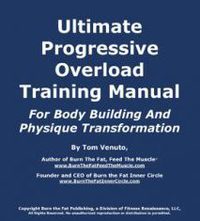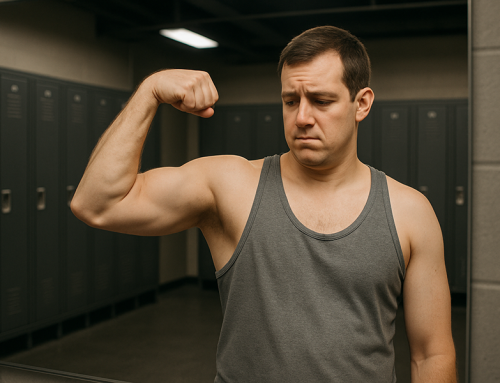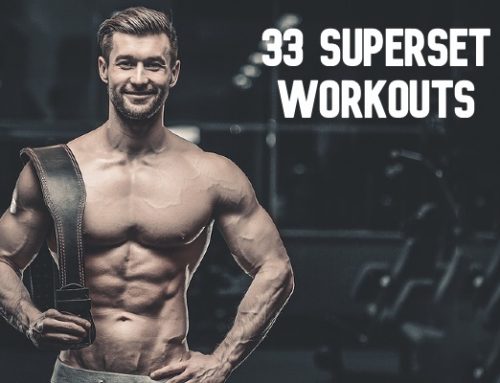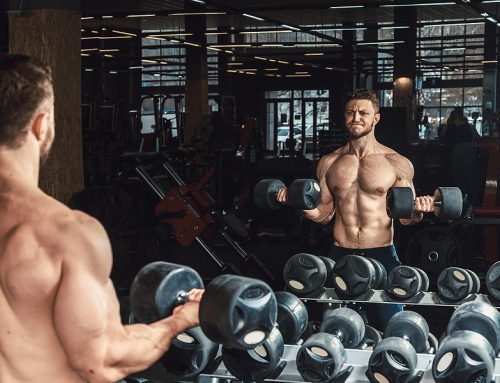Once you’ve planned out a weight training routine that follows all the best practices of good program design, the single most important thing you can do to gain muscle is consistently apply the principle of progressive overload…
 Progressive overload means gradually doing more over time.
Progressive overload means gradually doing more over time.
Most people think of it as more weight, but it also includes more reps, more volume, more quality, more intensity, more density, more difficult exercises and so on. In other words, don’t keep repeating the same workload.
Instead, do something you’ve never done before and push yourself a tiny bit further every time you train, even if it’s only one more rep. That’s how you make progress.
This sounds like a simple plan on paper, but as Mike Tyson once said, “Everyone has a plan, until they get punched in the face.”
Over time, as you push up your training volume, and especially as you try to lift heavier, you often run into a roadblock – you get hurt. Muscle pains, tendon strains, achy joints, extreme soreness or severe fatigue affect almost everyone at one time or another.
Sometimes it’s worse and you get injured: torn muscles, disc herniation, patellar tendinitis, shoulder impingement, elbow bursitis, blown rotator cuffs and a laundry list of other ailments are not uncommon among people who train hard for a long time.
When it hurts, following your plan is unpleasant. When you’re injured, it can knock you out of the game completely. Either way, your plan for progress gets thrown out the window. It’s frustrating.
Fortunately, you can reduce your risk of lifting-related injuries simply by following smart training guidelines which include:
- Warm up.
- Stay mobile/flexible.
- Avoid high-risk exercises.
- Use a spotter or rack.
- Maintain equipment and a safe training space.
- Never using more weight than you can handle with good form.
You probably know about these safety guidelines already and should certainly practice them, but that’s just injury prevention 101, so I’d like to go beyond the basics today and share with you some injury-free muscle-building ideas you may not have thought of before.
One of the most overlooked ways to stay out of the doctor’s office is changing the way you train completely, moving away from an “increase the weight at all costs” mindset and toward a more elegant style of physique training, which can be much more joint friendly and still put muscle on your body in all the places you want it.
This shift in strategy (and mindset) is even more vital as you get older. Through your 20’s and even your 30’s, you might be able to train heavy all the time or even train recklessly without consequences. Heavy lifting in the early stages is important for building a foundation. But as I’ve coached more men and women over age 40 to 50, I’ve heard the same complaint more often: “I’m in pain, and I can’t train.”
Depending on the recency and severity of an injury, you may need to work with a good doctor or rehab therapist. But the long-term solution may not lie in fancy treatments or expensive therapies but in two secrets that most people outside the old-school bodybuilding world don’t talk about nearly enough:
1. Change the way you lift to make a light weight feel heavy.
2. Achieve progressive overload with methods other than increasing weight.
You absolutely should lift heavier when you can do it safely and without pain. There’s no doubt that when all else is equal, lifting more builds more muscle. But when you can’t train heavier, you can also increase muscle growth by training with moderate and even light weights, if you know how.
The key is learning and using specific weight training tactics that increase the intensity of effort and overload your muscles in unique ways other than lifting heavier. There are 8 of them I’ll cover today.
1. Train with continuous tension
Continuous tension means that through an entire set, you do not stop, pause between reps or lock out a joint – you perform reps in a fluid up and down motion like a slow piston.
For example, in a squat or split squat, you stop just short of locking out your knees at the top – you never stand all the way up. In a barbell curl or a lateral raise, you don’t pause in the “dead spot” at the bottom, not even for a split second, you lift the weight right back up.
These simple tweaks in technique keep the target muscle under tension without a break, which makes the exercise harder. This also forces you to use less weight. At first you might think that’s a step backward, but despite the decrease in weight, there’s an increase in intensity of effort and your muscles are hit with new stress they aren’t used to.
Using continuous tension, the exercise becomes more metabolic and more blood is forced into and trapped in the muscle until the set is over. This creates conditions ideal for muscle growth.
Another benefit of continuous tension is that keeping the joint slightly unlocked keeps stress on the muscles and off inflamed joints. What’s more, continuous tension sets seem to work best with at least 8 to 12 reps, and upwards of 15 (occasionally more). Since low reps with heavy weight aren’t necessary to begin with, your joints will thank you twice.
Continuous tension training, especially in medium to high rep ranges is not easy because the nonstop reps cause lactic acid to build up, and the burn at the end of the set can test your toughness, mentally and physically. If you make it through, you’ll be rewarded.
2. Use peak contraction
Peak contraction means holding and squeezing (flexing) at the point during an exercise where maximum tension is on the muscle. Typically, you hold and squeeze in the contracted position for 1 to 5 seconds. I like to hold about 3 seconds, but also adjust the duration based on how it feels.
This tactic does not work optimally for every exercise. It works best when there’s maximum tension on the muscle in the top position. You have to analyze the biomechanics and resistance curve to determine which exercises are the best candidates.
For example, the cable flye for chest is a peak contraction exercise because the finish point of the exercise, where the hands come together, is the point of maximum tension. During a preacher curl on the vertical side of the bench, the top position gives you peak contraction, so holding at the top to squeeze is highly effective for building the biceps.
Like continuous tension and other techniques of this nature, you’ll probably have to reduce the poundage, yet holding and squeezing at precisely the right place on the right exercises will create a strong muscle contraction and stimulate your muscles to grow even with a lighter load, which usually makes this very joint-friendly.
3. Slow down your reps
Most people either lift the weight quickly, with about a second up and a second down, or they use a slightly controlled tempo of 1 or 2 seconds to lift the weight (concentric) and 2 to 3 seconds to lower the weight (eccentric). The tempo may also depend on the exercise.
Whatever your usual tempo, if you slow down and take 1.5 to 2 times as long, you will increase the focus on the target muscle because it’s impossible to cheat the bar up using momentum or secondary muscles.
A slow tempo rep might be 2 to 4 seconds on the lifting portion and 4 to 5 seconds on the lower portion, or you might simply take an even tempo both ways with 3 to 4 seconds up and 3 to 4 seconds down.
Like all these “quality over quantity” techniques, this will reduce the amount of weight you can handle, but that’s the whole idea. What you lose in poundage, you gain in muscle contraction, intensity of effort and time under tension. Because less weight is required, you can use this technique to train around injuries and joint pain.
You can however, get too much of a good thing. Do not think that if slow is good, then even slower is better. When the repetition speed gets too slow, the amount of weight you can handle is reduced so dramatically, it actually becomes less effective.
4. Improve your mind to muscle connection
For decades, bodybuilders have preached about the importance of putting the mind into the muscle, or differently stated, focusing your attention on the primary muscle you want to develop. In recent years this has received scientific support.
When researchers attach electrodes to the muscles used during a particular exercise and then instruct lifters to concentrate on the target area, including flexing or squeezing, and mentally focusing, measurements of muscle activity increase.
Powerlifters and weightlifters may use different types of coaching cues, including external cues, for building strength or hitting maximum lifts. But when it comes to building muscle without requiring heavy loads, a simple increase in concentration on the target muscle can improve your results.
This type of mental focusing is ideal when doing bodybuilding exercises in the hypertrophy rep range, which is usually between 8 and 12 reps. It’s an extremely effective way to improve training quality, and get more out of the same workout, while decreasing joint stress and injury risk at the same time.
5. Overemphasize form
Good form goes beyond simply doing reps a little slower or squeezing the muscle or increasing mental focus, because a rep done with control and intense focus but the wrong form is still the wrong form.
You must study each exercise to learn the correct range of motion, body position and bar path on every exercise. If you’re not sure, invest in good coaching. Keep getting form checks until you know you’ve got it.
If you’re training around pain or injury, it’s worth exaggerating good form to the point of what we could call “ultra strict.”
Your reps are slow and controlled, your mind is focused, the maximum tension is on the muscle at all times with zero extraneous body movement and the exercise technique is perfect as well.
There are all kinds of unique tricks you can use to over-emphasize good form – I could fill a book with them – and there is an ultra-strict version of almost every exercise. For example, instead of a standing barbell curl, where it’s easy to cheat by swinging the weight up, you can do the post curl with your back against an upright, or the Vince Gironda “perfect curl.” These types of modifications make it impossible to cheat and force you to reduce the weight, but the biceps must work harder.
I remember years ago when one of my (evil) trainers would put his fist between my shoulder blades every time I leaned back (“slight” cheating) when doing seated cable rows. It forced me to reduce the weight but improved my form. My upper back grew like never before. Even better, I never tweaked my lower back doing those strict rows even though I had a history of low back pain from a ruptured lumbar disc.
You can practice ultra strict form all the time if you choose, but at the very least, use it on all exercises where the movement is complex or on exercises that are high risk based on any orthopedic conditions you have.
6. Increase repetitions
Many people erroneously believe that the only way to overload your muscles is to lift more. If you can increase your weight while maintaining perfect form that’s ideal, but for many people, lifting heavier aggravates joint pain, especially on certain exercises. The good news is, if you simply do more reps with the same weight, you’ve still made progress.
Most people have been told that heavier weight and low reps builds muscle and strength and training with high reps is a wimpy workout that builds muscle endurance but not any muscle size. This is not true.
First of all, high rep sets on compound exercises are not wimpy. The 20-rep squat routine for example, is a classic and is infamous for being one of the toughest workouts of all time. Some of the most muscular bodies in bodybuilding history were built with high rep sets of 12, 15, 20 reps or more.
High rep training can do more than build endurance, it can also increase muscle size, especially in the type I muscle fibers.
If you’ve been training in the classic body building rep range which is usually 6 to 12 reps, when you build up to 12 reps, you are typically instructed to increase the weight, drop the reps back down to the lower number and repeat the process.
But if you have concerns about joint pain or injury when using heavier weights, instead, try to continue increasing the reps. Make your goal 13, then 14, 15, even 20 reps or more and see what happens. The results may surprise you.
7. Use multi-rep range training
Training with heavy weight and low reps is not inherently dangerous or injury-producing. Many powerlifters and weight lifters do it for years without incident. It’s more a matter of risk versus benefit based on your situation, as well as your goals. However, if your situation involves working around an injury or avoiding re-injury and if your goal is to get fit and muscular, you should re-think your rep strategy.
If you’re not a powerlifter, there’s no need to train like one, with most of your reps in the 1 to 5 rep max range, yet there are plenty of trainers today with a background in strength sports who want you to train like them, regardless of your goals.
There is substantial evidence supporting the use of multiple rep ranges for muscle growth rather than training heavy all the time. Even if there weren’t, it makes sense to mix up your rep ranges for the sake of preventing injury and overtraining.
A simple periodization plan where you have lighter and heavier days or light, medium and heavy days, can provide great relief to sore joints and tendons compared to training heavy at every workout.
If you have recurring pain in a particular joint or muscle, there’s no reason you couldn’t drop the heavy day completely and simply rotate a medium day of 8 to 12 reps and a high rep day of 15-20. Your medium day is now your “heavy” day, which can save your joints and produce better results than if you did high reps alone.
8. Increase the density
Density refers to how tightly packed something is. In the case of lifting, it means how much work you get done in a given amount of time.
If you were doing 15 sets in one hour and you condensed those 15 sets into 40 minutes, you’ve done the same work in less time, and successfully overloaded your muscles. You’ve also made your workout more time efficient. If you were doing 15 sets in an hour and you squeezed 18 sets into 40 minutes, that’s even better because now you’ve done more work in less time.
The way most people increase density is by reducing rest intervals between sets. Standard advice is to take 2 to 3 minutes between sets for large muscle group and compound exercises, 1 to 1 ½ minutes for smaller muscles and generally, before doing the next set, wait until you feel recovered enough to do it with full strength and energy.
The common criticism of cutting rest intervals to a minute or less is that you can’t fully recover in between sets, so the number of reps you can do with each subsequent set will drop, or you may have to reduce the weight due to the residual fatigue.
But remember, one of the secrets of continuing to lift weights and gain muscle without aggravating joint pain is to make a light weight feel heavier. Slower reps, continuous tension and peak contraction all make a light weights feel heavier. So does reducing your rest intervals.
Another method of increasing density is using supersets. Supersetting is where you perform two exercises back to back with little or no rest between, then take a regular rest interval after each pair is completed. One of the most popular and scientifically supported superset techniques is the antagonistic or opposite muscle method.
More neglected but possibly even better for people training around injuries is doing two exercises back to back for the same muscle, including the pre-exhaustion method where an isolation exercise is done before a compound exercise (reverse of the usual exercise order).
You should not expect to use as much weight when doing short rest interval weight training or certain types of supersets, but once again, that’s the whole idea. The goal is not maximum strength – it’s getting a good muscle-building workout without pain or injury. Superior time efficiency is a great bonus.
Conclusion
Keep in mind that you can get stronger using these techniques, but they are not intended to develop limit strength. For the competitive or recreational body builder struggling to train around pain, and for many people, after a certain age, maximum strength is no longer the goal anyway.
These techniques are also not necessarily better at building muscle size than regular straight sets with traditional reps and heavier weights (although it’s possible they might).
What these techniques will do is help you increase your muscular development above where it is now even if you’re currently struggling to work around injuries. These methods will also reduce your chances of getting injured in the future. This style of training, using “classic bodybuilding” techniques, can be a godsend for people over 40 or 50 with joint pain.
Don’t take my word for it – give them a try and see for yourself. But be sure to leave your ego at the door. Building a muscular body isn’t always about seeing how much weight you can lift – but it does take a different kind of very hard work to train with these methods. It’s not about lifting with brute force, but about lifting with finesse.
Want to learn more?
Progressive overload is a fascinating subject, and it’s fun, not only because by using it, you can enjoy perpetual progress that you can measure and see, but because it’s more than a science – it’s an art, a pursuit where you can strive for mastery for the rest of your life.
To learn more about progressive overload systems, the ULTIMATE progressive overload training manual for body building and physique transformation was just released and you can get your copy here:
CLICK HERE To Download Your Progressive Overload Training Manual

Tom Venuto is a lifetime natural (steroid-free) bodybuilder, fitness writer and author of Burn The Fat, Feed The Muscle: Fat Burning Secrets of Bodybuilders and Fitness Models and the national bestseller, The Body Fat Solution, which was an Oprah Magazine and Men’s Fitness Magazine pick. Tom has appeared in The New York Times, Wall Street Journal, Huffington Post, Oprah Magazine, Muscle and Fitness Magazine, Ironman Magazine and Men’s Fitness Magazine, as well as on dozens of radio shows including Sirius Satellite Radio, ESPN-1250 and WCBS. Tom is also the founder and CEO of Burn The Fat Inner Circle – a fitness support community for inspiration and transformation







This is something I hope most new lifters really take the time to understand, they focus more on supplements, what lifts to do but how to go about all of this without injuries is something that seems to be something that only gets thought about until it happens.
Guess it’s part of that, young and invincible type of feeling that most of us men go through.
Never heard of progressive overload
I really liked the content, congratulations.
What a great article! Eye opening and true.
I guess this is one of the most important posts on Weight Training where the actual issues have been explained so well.
Thanks for sharing your info.